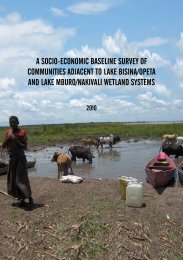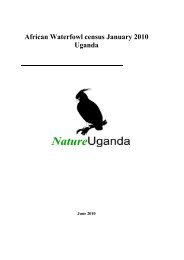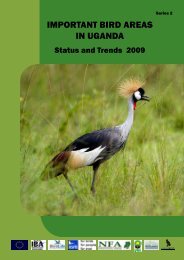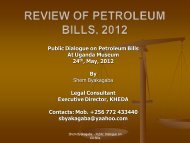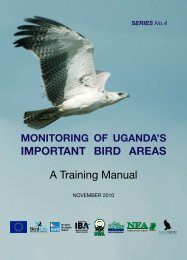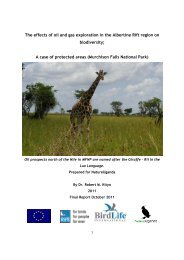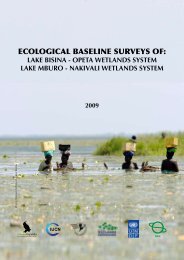the economic valuation of the proposed ... - Nature Uganda
the economic valuation of the proposed ... - Nature Uganda
the economic valuation of the proposed ... - Nature Uganda
You also want an ePaper? Increase the reach of your titles
YUMPU automatically turns print PDFs into web optimized ePapers that Google loves.
describe three contexts in which such values might<br />
arise. They are:<br />
» someone may express a willingness to pay to<br />
conserve <strong>the</strong> forest in order that <strong>the</strong>y may make<br />
some use <strong>of</strong> it in <strong>the</strong> future, e.g. for recreation.<br />
This is known as an option value;<br />
» someone may express a willingness to pay to<br />
conserve a forest even though <strong>the</strong>y make no<br />
use <strong>of</strong> it, nor intend to. Their motive may be that<br />
<strong>the</strong>y wish <strong>the</strong>ir children or future generations to<br />
be able to use it. This is a form <strong>of</strong> option value<br />
for o<strong>the</strong>rs’ benefit, sometimes called a bequest<br />
value; and<br />
» someone may express a willingness to pay<br />
to conserve a forest even though <strong>the</strong>y make<br />
no use <strong>of</strong> it, nor intend to, nor intend it for<br />
o<strong>the</strong>rs’ use. They simply wish <strong>the</strong> forest to<br />
exist. Motivations may vary, from some feeling<br />
about <strong>the</strong> intrinsic value <strong>of</strong> <strong>the</strong> forest through<br />
to notions <strong>of</strong> stewardship, religious or spiritual<br />
value, <strong>the</strong> rights <strong>of</strong> o<strong>the</strong>r living things, etc. This<br />
is known as existence value (Pearce & Pearce<br />
2001).<br />
While extremely difficult to determine <strong>the</strong> relevance<br />
<strong>of</strong> <strong>the</strong> option and existence values is that <strong>the</strong>y may<br />
be ‘capturable’ through mechanisms such as debt-for-<br />
nature swaps, <strong>of</strong>ficial aid, donations to conservation<br />
agencies, and pricing mechanisms (Pearce &Pearce<br />
2001). According to Swanson & Kontoleon (2000), an<br />
example <strong>of</strong> using a price is <strong>the</strong> suggestion that visitors<br />
to China would have <strong>the</strong> option <strong>of</strong> paying $1 extra<br />
for a panda stamp’ in <strong>the</strong>ir passports, along with <strong>the</strong>ir<br />
visa, to indicate that <strong>the</strong>y have donated towards panda<br />
conservation in China.<br />
Some option and existence value estimates for <strong>the</strong><br />
world’s tropical forests have been reported elsewhere<br />
including: Sri Lankan forests (villagers, rural and urban<br />
groups <strong>of</strong> use, bequest and existence values) by<br />
Gunawardena et al (1999) using a contingent <strong>valuation</strong><br />
method (CVM); and US residents’ willingness to pay ‘one-<br />
<strong>of</strong>f’ payment <strong>of</strong> $21-31 per household for protection <strong>of</strong> 5<br />
percent more <strong>of</strong> <strong>the</strong> world’s tropical rain forests (Kramer<br />
&Mercer 1997). However, for purposes <strong>of</strong> arriving at a<br />
relevant estimate for <strong>the</strong> impact area in Mabira three<br />
studies are particularly pertinent. The first concerns use<br />
<strong>of</strong> a willingness to pay study to estimate <strong>the</strong> implied<br />
‘world’ willingness to pay for limited forest areas covered<br />
by debt-for-nature swaps at $5/ha (Pearce 1996).<br />
The second study is a similar one by <strong>the</strong> same author<br />
on implied ‘world’ willingness to pay via <strong>the</strong> Global<br />
Environmental Facility (GEF) <strong>of</strong> $2/ha.<br />
The third study was estimates <strong>of</strong> option and existence<br />
values revealed in a study <strong>of</strong> debt-for-nature swaps<br />
and grant aid to Mexico forest conservation <strong>of</strong> $12/ha.<br />
For <strong>the</strong> impact area in Mabira, <strong>the</strong> implied willingness<br />
to pay via <strong>the</strong> GEF facility was chosen mainly because<br />
it represents <strong>the</strong> most conservative estimate but also<br />
because <strong>Uganda</strong> has been a beneficiary <strong>of</strong> several GEF<br />
funding arrangements 9 .<br />
From <strong>the</strong> foregoing, <strong>the</strong> unit option and existence<br />
value for <strong>the</strong> Mabira impact area would be $2/ha,<br />
which when multiplied by <strong>the</strong> 7186ha translates into<br />
$14,372/annum (or UShs 24,432,400/year using 1 US$<br />
= UShs 1,700) and a present value <strong>of</strong> about $119,767<br />
(or UShs 203,603,900).<br />
5.4. SUMMARY<br />
The results <strong>of</strong> <strong>the</strong> foregoing analysis are summarised<br />
in Table 21. The value <strong>of</strong> <strong>the</strong> timber growing stock in<br />
<strong>the</strong> impact area (40 cm dbh+) was estimated at about<br />
US$35.2 million. Irrespective <strong>of</strong> <strong>the</strong> use to which <strong>the</strong><br />
timber maybe put, it holds a stored carbon value <strong>of</strong><br />
US$3.7 million. For purposes <strong>of</strong> comparing <strong>the</strong> merits<br />
and demerits <strong>of</strong> <strong>the</strong> <strong>proposed</strong> land conversion, <strong>the</strong><br />
stored carbon value will be ignored. It is assumed that <strong>the</strong><br />
growing timber stock will be converted into sawnwood<br />
and used fur<strong>the</strong>r in o<strong>the</strong>r processes or products (e.g.<br />
9 Including part <strong>of</strong> <strong>the</strong> World Bank support to <strong>Uganda</strong> under<br />
<strong>the</strong> Environment Management Capacity Building Project (EMCBP)<br />
for NEMA; and <strong>the</strong> Protected Area Management and Sustainable Use<br />
(PAMSU) whose beneficiaries include UWA, MTTI, Museums &<br />
Antiquities and UWEC, among o<strong>the</strong>rs.<br />
The Economic Valuation <strong>of</strong> <strong>the</strong> Proposed Degazettement <strong>of</strong> Mabira CFR | 2011 45



